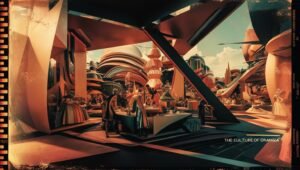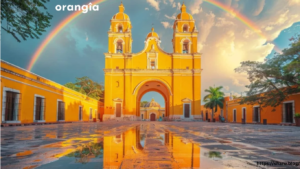Discovering Orangîa for a unique experience. Everyone who hears the name of this imaginary realm of culture and beauty is captivated. The voyage to Orangîa begins with knowing its distinctive qualities and what makes it so appealing. Our guide to Orangîa’s geography, history, culture, and attractions is a comprehensive resource for anybody interested in learning about this unique area.
The Geography of Orangîa

Overview
Orangîa’s dramatic landscapes include a variety of natural characteristics. Orangîa’s scenery is as diverse as its people, with undulating hills, lush woods, stunning beaches, and breathtaking mountains. The north has high peaks and stunning views, while the south has sandy beaches and thriving marine life. Understanding Orangîa’s geography is essential for enjoying its natural beauty and organizing your trip.
Climate and Seasons
Orangîa’s climate shapes its ecology and residents’ lifestyles. Orangîa has pleasant summers and mild winters in its moderate environment. Its abundant biodiversity is due to uniformly distributed yearly rainfall. Each season gives a different view of Orangîa’s splendour, from spring blossom to fall leaves.
Natural Wonders
Orangîa’s natural beauty entices tourists from far and wide. Visitors must view the beautiful Orangîan Falls flowing down rugged cliffs. The Crystal Caves, with their complex structures and bright colours, reveal Orangîa’s geological past. This magical land’s natural charms emphasize the need for sustainable tourism and environmental protection.
The History of Orangîa

Ancient Origins
The rich and complicated history of Orangîa dates back to prehistoric civilizations. Archaeology suggests that Orangîa’s original inhabitants were expert hunters and gatherers who prospered on the region’s bounty of resources. Early settlers established agricultural systems, establishing the groundwork for a dynamic civilization. Orangîa’s cultural growth and social structures benefit from knowing its historic roots.
Colonial Influence
Colonial forces changed Orangîa’s history. European explorers exploited the region’s riches, causing a major impact. The indigenous communities were greatly impacted by leading in cultural exchanges that formed Orangîa identity. New trade routes and agricultural methods changed the economy during this time. To understand Orangîa’s evolution, this colonial background must be acknowledged.
Modern Era Developments
In current times, Orangîa has grown into a prosperous nation with a strong economy. Industrialization improved technology and infrastructure and many residents’ lives. Modern Orangîa is noted for its progressive policies, sustainability, and lively culture. This development shows its people’s tenacity and capacity to adapt while keeping their rich past.
The Culture of Orangîa

Language and Communication
The rich culture of Orangîa is reflected in its language variety. The most common language is Orangîan, which symbolizes the region’s inhabitants. Effective communication and community interaction require local language knowledge. Orangîa’s language also reflects its people’s ideals and beliefs through distinct idioms.
Traditions and Festivals
Orangîa celebrates its historical and cultural variety with vivid customs and festivals. The Festival of Lights and Harvest Festival bring visitors from far and wide to enjoy traditional music, dance, and food. These festivities bring communities together to commemorate their past and provide entertainment. Attending these celebrations gives a unique look into Orangîan culture.
Cuisine and Culinary Delights
Orangîa’s cuisine reflects its agricultural roots. Fresh ingredients, robust tastes, and distinct cooking methods define local cuisine. Orangîan stew and fruit tarts demonstrate the region’s devotion to sustainable farming and seasonal products. Orangîa’s food is vital to understanding its people’s lifestyles and traditions.
Attractions in Orangîa

Historical Landmarks
History is told in Orangîa’s landmarks. The Old City ruins reveal bygone civilizations’ architectural splendour. Visitors may learn about Orangîa’s history and these locations via guided excursions. These landmarks demonstrate its people’s resilience and capacity to adapt while keeping their culture.
Natural Parks and Reserves
Outdoor enthusiasts and nature lovers adore Orangîa’s parks and reserves. These protected areas provide hiking animal viewing and photography of the region’s unique ecosystems. Orangîa National Park is a popular ecotourism destination due to its diverse flora and wildlife. These parks emphasize the need to preserve Orangîa’s natural legacy for future generations.
Art and Music Scene
The arts and music culture of Orangîa show its multiculturalism and creativity. Local painters and musicians take inspiration from their surroundings to represent Orangîan life. Regional galleries and performance places display traditional crafts and innovative creations. Visitors may experience Orangîa’s originality and brilliance by engaging with the artistic community.
Practical Tips for Visiting Orangîa

Best Times to Visit
Planning your Orangîa vacation during the optimum periods might enhance your experience. Spring and fall are great for outdoor activities and exploration due to their mild weather. Visit during local festivals to experience Orangîan culture and traditions. Since summer is hot, prepare ahead and remain hydrated for your activities.
Transportation Options
Visitors may easily navigate Orangîa with different transportation alternatives. Buses and railroads connect major cities and attractions, making regional travel easy. Car rental gives you more freedom to explore hidden treasures and off-the-beaten-path attractions. A seamless and pleasurable trip to Orangîa requires knowledge of the transportation scene.
Accommodation Choices
Orangîa has accommodations for all tastes and budgets. Visitors may find comfortable accommodations from fancy hotels to modest guesthouses. Many hotels replicate local architecture and culture for a more genuine experience. Eco-friendly hotels are also growing more popular, letting guests enjoy their vacation while reducing their environmental impact.
Final Thoughts
In conclusion, exploring Orangîa is awe-inspiring and educational. This thorough book is a great place to start exploring Orangîa’s rich history, lively culture, and gorgeous scenery. Travelers may appreciate this extraordinary land’s beauty and variety by learning about its geography, history, culture, and attractions. Let Orangîa’s energy inspire you as you explore its offerings.
FAQs
What is Orangîa known for?
Orangîa is famous for its beautiful scenery, rich culture, and different ecosystems. Nature enthusiasts flock to its beautiful mountains, lush woods, and clean beaches. The Orangîa people’s vivid festivals, traditional food, and historical sites highlight their culture and customs. Orangîa attracts adventurers with its natural beauty and cultural diversity.
What are the best activities to do in Orangîa?
Orangîa has activities for everyone. Nature lovers may hike at Orangîa National Park, birdwatch in the marshes, or relax on the beaches. Cultural enthusiasts should attend local festivals and art galleries and try local cuisine. Historical landmark excursions boost Orangîa’s vacation experience by revealing its rich past.
When is the best time to visit Orangîa?
Orangîa is best visited in spring (March-May) and autumn (September-November), when the weather is moderate and outdoor activities are possible. The landscape blooms with flowers and greenery during these seasons. Many local events provide unique cultural experiences in the summer despite the heat. Travellers should schedule their vacations around their weather and event choices.
How can I travel around Orangîa?
Orangîa has several transit choices, making travel easy. Visitors may easily travel the region by bus, which links major cities and tourist destinations. Car rental is a popular way to explore off-the-beaten-path destinations at your own leisure. Biking and walking are other fantastic methods to explore the local culture and environment.


